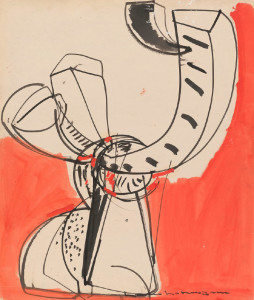255 Worth Avenue
Palm Beach FL
T 561-328-9505
Lisa@borghi.org
HOFMANN and AVERY
April 13, 2017– June 15, 2017
-

Hans Hofmann ( 1880-1965) Untitled c.1945 Gouache on paper 26 x 22 inches
HOFMANN and AVERY
My aim in painting is to create pulsating, luminous, and open surfaces that emanate a mystic light, in accordance with my deepest insight into the experience of life and nature.
Hans HofmanNature is my springboard. From her I get my initial impetus. I have tried to relate the visible drama of mountains, trees, and bleached fields with the fantasy of wind blowing and changing colors and forms.
Milton AveryThe framing of a Hans Hofmann and Milton Avery exhibition is about one thing, the dazzling affect color has in abstraction. Hofmann and Avery are pivotal artists in the transitional role New York took in modern art.
Hans Hofmann began his career by visiting Paris’s thriving art scene, meeting such artists as Pablo Picasso, Henri Matisse and Georges Braque and Robert Delaunay. During this period, the work Hofmann created followed the leading avant-garde movement of the time—cubism. In 1910, Hofmann had his first solo show in Berlin. Living back in Germany at the start of World War I, Hofmann was excused from military service because of an earlier respiratory condition. Unable to return to France during the war, he opened an art school in Munich in 1915. Over the years, Hofmann earned a stellar reputation as an instructor of art. Worth Ryder, a former student, invited Hofmann to teach in the United States for the summer of 1930. Germany’s changing political climate made Hofmann decide to permanently settle in the United States in 1932. Hofmann based himself in New York City, where he worked as an instructor at the Art Students League before establishing his own school in the city. In 1934, Hofmann began a summer program in Provincetown, Massachusetts. Becoming known for his abstract paintings, Hofmann landed a solo exhibition at Peggy Guggenheim’s Art of This Century gallery in 1944. In 1957, his work was the subject of a retrospective showing at New York’s Whitney Museum of American Art. The next year, Hofmann retired from teaching in order to focus on creating art. Hofmann was selected to represent the United States at the Venice Biennale in 1960, alongside Philip Guston, Franz Kline and Theodore Roszak. By then, he was considered a leading abstract expressionist who created vivid and inventive paintings. In 1963, the Museum of Modern Art mounted a major exhibition of his work.
Milton Avery was born at Sand Bank, New York. After studying for a while at the Connecticut League of Art Students in Hartford under Charles Noel Flagg and at the Art Society School there under Albertus Jones, Avery worked in manufacturing and with an insurance company until 1924. He moved to New York in 1925 and married the artist Sally Michel, an illustrator, a year later. He had his first one-man show as early as 1928 at the Opportunity Gallery in New York. The decades that followed saw him show work at numerous exhibitions mounted by New York galleries and American museums. Milton Avery’s preoccupation with French Fauvism and German Expressionism led him to develop a simplified formal idiom distinguished by clarity of line and an expressive palette. Where as Avery’s early figurative drawings and paintings from the 1930s attest to affinities primarily with the work of Ernst Ludwig Kirchner, by the 1940s he was discernibly close to Henri Matisse. As the American upholder of Matisse’s colouristic doctrine, Milton Avery developed the French artist’s decorative colour surfaces into subtly toned colour zones, thus breaking the ground for the Colour Field painting of Mark Rothko and Adolph Gottlieb, both of whom were friends of his. Even though his style was close to abstraction, Milton Avery nonetheless clung to representation throughout his entire career. Classical motifs and subject matter in portraits, still lifes and coastal landscapes were his main thematic areas and genre
